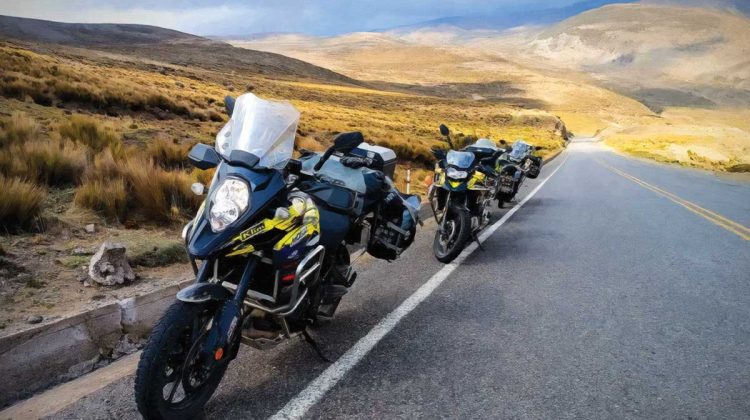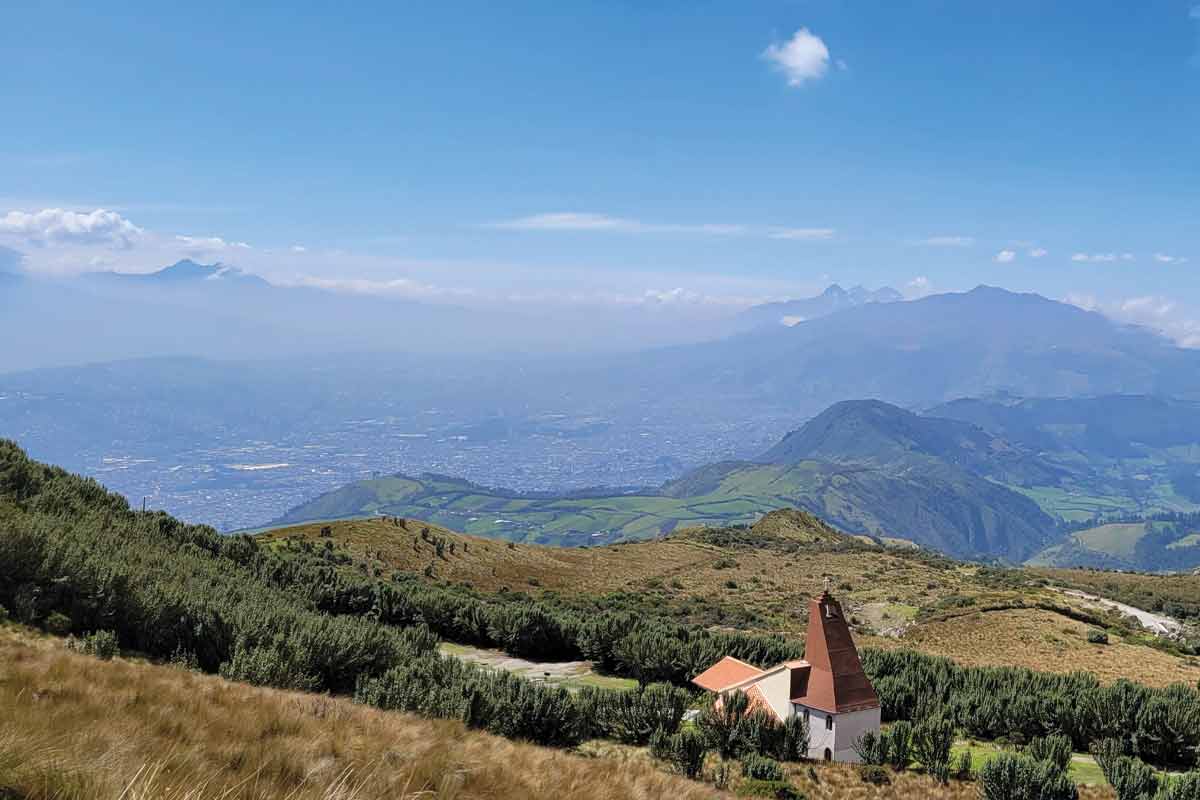
Before the advent of modern geography or GPS systems, the native people understood this place to be at the center of the world. It wasn’t until 1736 that the French Geodesic Mission launched an expedition to measure the equatorial line of the earth that the world learned what the native people already knew. My first experience on the back of a motorcycle was in my early 20s. With some trepidation, I climbed on behind my boyfriend at the time. He loved his Kawasaki ZX9. He also loved the speed and power of that bike. I did not. I vowed to never ride on a motorcycle again.
Several years later, I fell in love with another motorcycle enthusiast. Once I tried riding with him, I realized that not all motorcycle riders are created equal. My husband, Phil Cann, owns Asheville Motorcycle Rentals, so I suppose it was inevitable that I would spend many days riding pillion on various bikes. From the seats of Harley-Davidsons, BMWs and Triumphs, the roads of Western North Carolina have unfolded before me.
A few years ago, Phil began talking more about Ecuador Freedom Bike rental based out of Quito. This company runs guided and self-guided tours throughout the country. For many months I watched in vain as he tried to cajole and encourage a few friends to join him on one of their off-road tours. Due to reasons ranging from COVID to family struggles, no one was able to commit to that trip; so, as any supportive wife would I offered to go with him as a passenger.
His ill-concealed pout and pregnant pause told me that my presence would put the kibosh on the off-road ride he wanted to do, but to his eternal credit, he quickly shifted to trying to sound excited about an on-road ride with me sitting pillion. We decided upon the Introduction to Ecuador guided tour. This 12-day excursion covered nearly the entire country beginning in Quito, heading north just shy of the Colombian border, west to and along the coast heading south toward the Peruvian border before turning east then north through the Amazon before climbing once more into the Andes on the return to Quito. We choose this tour as we thought it would give us the most wide-ranging view of the country and its people.
We had a small group of four — Phil and me on a Triumph 900; John, a middle-aged man from Austin, Texas; and Sally a British ex-pat living in Portugal along with our intrepid guide, Juca.
Sitting in a briefing room at Freedom’s headquarters, Juca drew two solid parallel lines on a dry-erase board with a dotted line in between.
“How many lanes of traffic does this road have,” he asked. I gathered this may be a trick question. “There can be as many as five lanes of traffic on this road, so it’s important to be watchful.”
He followed this up with the road laws of the country which seemed wildly erratic to me. On speeding, if caught going more than 10 kilometers per hour (6 mph) over the limit, one could get a fine of up to several hundred dollars, greater speeds than this and you could face up to three days in jail.
Ecuador’s road systems reminded me of the chaotic highways I remembered from traveling in South Asia and Central America where the road is shared by any description of motor vehicle, cyclist, pedestrian, stray dogs, small herds of farm animal, or even a horse and rider. In addition to the traffic, there are occasional and abrupt landslides capable of washing out whole mountainsides. Here I would be entirely open to the chaos and wholly dependent upon the quick reflexes of my husband.
The longest stint I have been on a motorcycle was two days. This tour was 12 days. As we left Quito, I began to wonder what on earth I had signed myself up for. Though I still wore the full riding gear with armor and a full-face helmet I learned that being on a motorcycle is something of a whole sensory immersive experience, something I had not encountered riding around the mountains of North Carolina.
I felt every bump and pothole in the road, I breathed in the diesel fumes and tasted the sea air as we approached the Pacific coast. I heard the calls of the market stall sellers along the roads of the small villages we rode through and saw it all with wide unblinking eyes trying to capture every detail. Robert Pirsig summed it up when he wrote in “The Zen and The Art of Motorcycle Maintenance:”
“In a car you’re always in a compartment, and because you’re used to it you don’t realize that through that car window everything you see is just more TV. You’re a passive observer and it is all moving by you boringly in a frame. On a cycle the frame is gone. You’re completely in contact with it all. You’re in the scene, not just watching it anymore, and the sense of presence is overwhelming.”
The oldest of any South American capital city, Quito is a vast sprawling metropolis of about two million people that sits at a little less than 10,000 feet in elevation on the lower slopes of the Pichincha Volcano. It stands second behind La Paz, Bolivia, as the highest capital city in the world. It also has the distinction, thanks to its incredibly well-preserved historic colonial district, to be named by UNESCO as the first World Cultural Heritage City.
Leaving Quito, we pointed our wheels north and begin our journey. One of our first stops was Mitad Al Mundo, where the Inti-nan Museum is located. The museum straddles the equator, giving curious tourists didactic displays to illustrate the Coriolis effect and other intriguing illusions unique to the equator, between the northern and southern hemispheres. “Inti-nan” in the native Quechua language means “the middle of the world.”
Before the advent of modern geography or GPS systems, the native people understood this place to be at the center of the world. It wasn’t until 1736 that the French Geodesic Mission launched an expedition to measure the equatorial line of the earth that the world learned what the native people already knew. Incredibly, the site where the mission measured the equator to be is merely 200 meters away from where we know the actual equatorial line is today. Leaving the museum and the center of the world, we head for the smooth undulating roads of Ecuador’s northern hemisphere.
It isn’t until day two that the Andes’ peaks which stood as sentries above us finally bent their backs to meet us. The landscape changed from a semi-arid high desert to gently sloped farms of papayas, mangoes, and cocoa trees before yielding to coastal mangroves and rocky beaches. The Pacific coast greeted us with a humid kiss leaving a salt rime on our skin. We spent two days following the coast, long stretches of beaches dotted with small coastal communities dedicated to surfing or tourism. In these sleepy coastal towns, we must have presented a singular presence. At every stop inevitably a small crowd would politely mill a few feet off from our small motorcycle collective. The bold — usually young men or children- —would approach and ask polite questions about the bikes or, in many cases, ask for their photos to be taken with one or all of us. It occurred to me that in a country where the average salary is $400 per month, an imported European motorcycle would be well outside of the means of many citizens.
By the fifth day, we finally said our farewell to the coast and headed east. It was one of the longest days of riding, 412 km, nearly 260 miles, and 11 hours door-to-door. As a passenger, it was the most challenging day of our trip. The roads were dusty and potholed, so our progress was sluggish, at best. The sun was hot and unrelenting, and it seemed the road took us through town after town congested with cars and motorcycles jockeying for position. Each town would have a series of speed bumps, the Spanish translation of the name translates to “speed wall.”.
These behemoths can launch an unsuspecting passenger in the air to land hard on against the rider. By the time we reached our hotel, my body was as sore as my mood. After a short walk and a well-deserved margarita, I apologized to Phil. I had imagined that with every move I made on the bike, he would feel it twice as much. Up to this point, I had been entirely comfortable with my position on the back and, besides, had far too much in the way of scenery to distract me. He took pains to insure me that isn’t the case and congratulated me on being such a pleasant passenger. When I asked what he meant, he went on to talk of other passengers who held on too tight, leaned too early into a curve, or didn’t lean at all, and in one case a passenger who fell asleep causing her head to fall forward and bang into the back of his. In earnest, he told me that he nearly forgot he had a passenger at all, and that was a very good thing.
Our remaining days of riding away from the coast back toward the Andes were beautifully undulating, dipping and twisting with the rise and fall of the land. Coming into Vilcabamba, the land rose sharply bringing us to a mountain apex, like the peak in a child’s drawing, where we met the clouds as they traversed the summit forming in cottony fingers as they moved down the opposite slopes following our own path into a wide green valley with gently rolling hills below.

Vilcabamba is a popular tourist destination and has a large community of American and European ex-pats. I wonder if its popularity is in large part due to its reputation for inhabitants living to extreme old age. Reports claim villagers living well beyond a century to ages of 120 years and more, hence earning the well-deserved moniker of The Valley of Longevity.
Moving through this area we begin to see more and more women and men in traditional dress. I find the women’s costumes in particular the most captivating. Often, it is a simple solid-colored top paired with a knee-length skirt in a vibrant color adorned with a patterned trim along the bottom, a shawl of rainbow colors wrapped around their shoulders, and, often, a small plain black fedora atop their heads. I am struck by the beauty and simplicity of this costume, so plucked up the courage to approach a woman. May I please take your photo, I asked in Spanish. Without slowing her pace and shaking her head no, she agreed only if I paid her. I understood that I would likely be leaving Ecuador without this picture.
So many of the towns and villages we passed through bore the heavy influence of European culture. As Ecuador’s resources were discovered — gold, shrimp, cacao, and oil — all manner of Europeans flocked to the country to be the first to benefit and, in doing so, left extraordinary examples of architectural magnificence. Nowhere did we see more of this than in Cuenca, a little European enclave in the middle of Ecuador replete with wide city plazas surrounded by gothic-style cathedrals, sidewalk boutiques, and cafes housed in grand examples of colonial architecture serving espresso and croissants.
We continued to ride higher in elevation, a green patchwork of farms dotted the sloping mountainsides. At moments I could have believed we were on a road wending through Irish countryside had it not been for Eucalyptus lining the roads and the fact that we were at 13,000 feet. At the pinnacle, we reached a little over 14,000 feet on the bikes before quickly descending into the lush and verdant Amazon jungle. It is somewhat of a shock to the system to ride in a matter of hours from high altitude to the heart of the Amazon. Toes and fingers numb from the cold were now sweating in winter gloves. Each of us shed layers like skin when we finally stopped.
The end of our tour seemed to come far too quickly. Starting this journey with a handful of local rides as a passenger, I wasn’t sure what state my mind (or backside) would be by the end; however, I surprised myself at how much I loved it. I came to understand in a way I never have riding through the mountains of North Carolina, that being on the road atop a motorcycle is a uniquely engaging experience.
As the miles rolled away and we approached Quito, once again I witnessed the jungle transform into the cloud forest before retreating completely as buildings replaced trees as we crept closer to the slopes of the Pichincha volcano and the sights and sounds of the city filled the space around us. We arrived back at Ecuador Freedom’s headquarters late afternoon greeted by members of staff and the two owners, Court and Sylvan, with hearty congratulations and a celebratory beer. As we settled into our final hotel, officially at the conclusion of our adventure, I struggled to understand my restlessness and then it struck me with some astonishment: I wanted to get back on the bike and ride.
I immediately recalled another of Pirsig’s sage passages from “Zen and The Art of Motorcycle Maintenance:” Sometimes it’s a little better to travel than to arrive.


